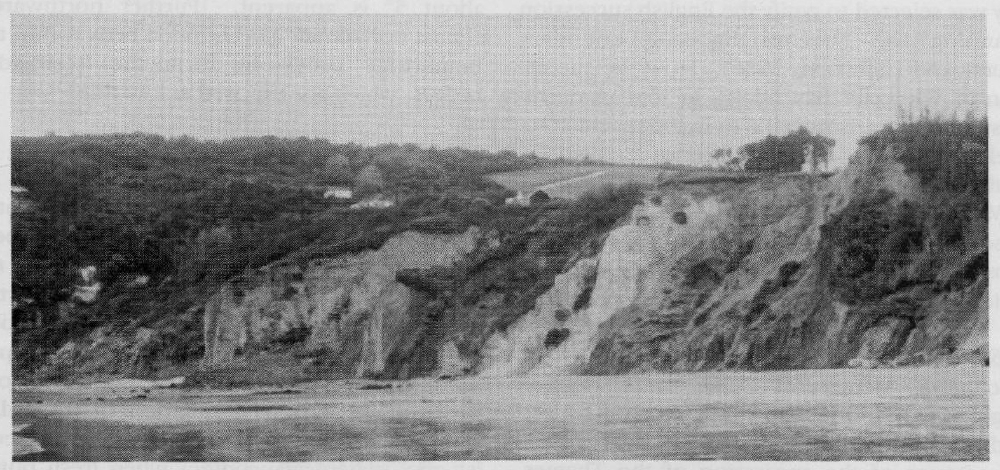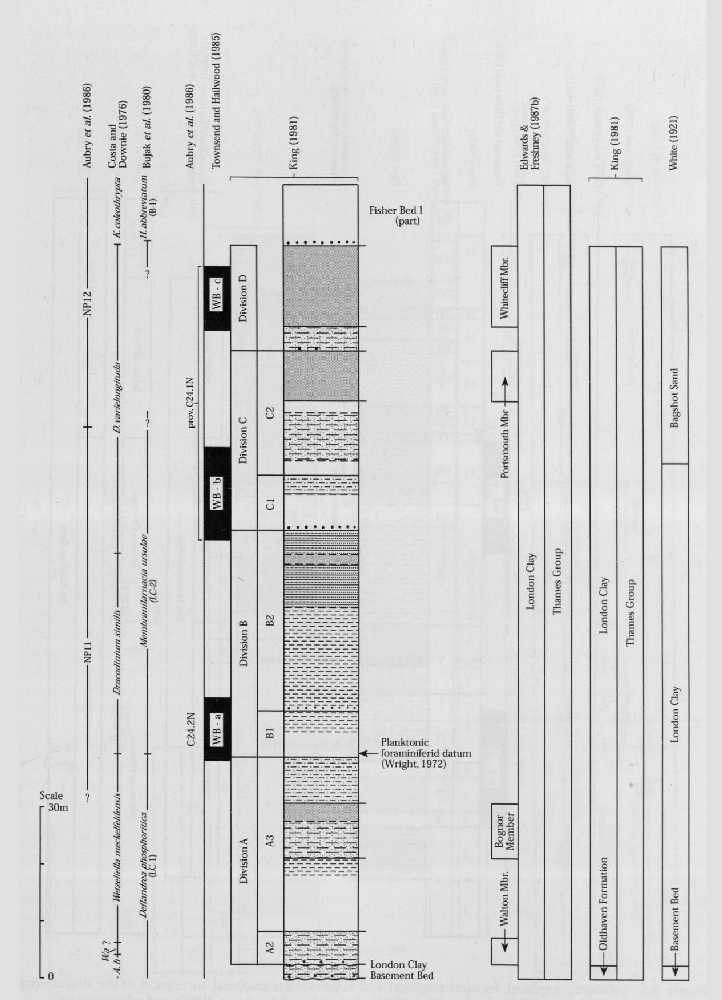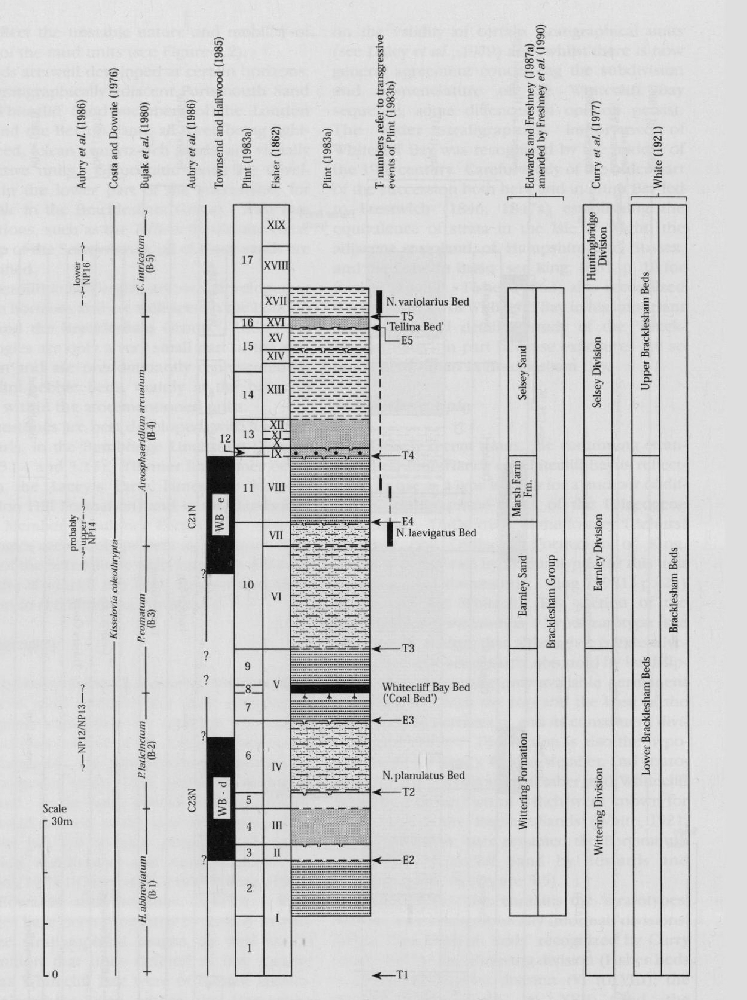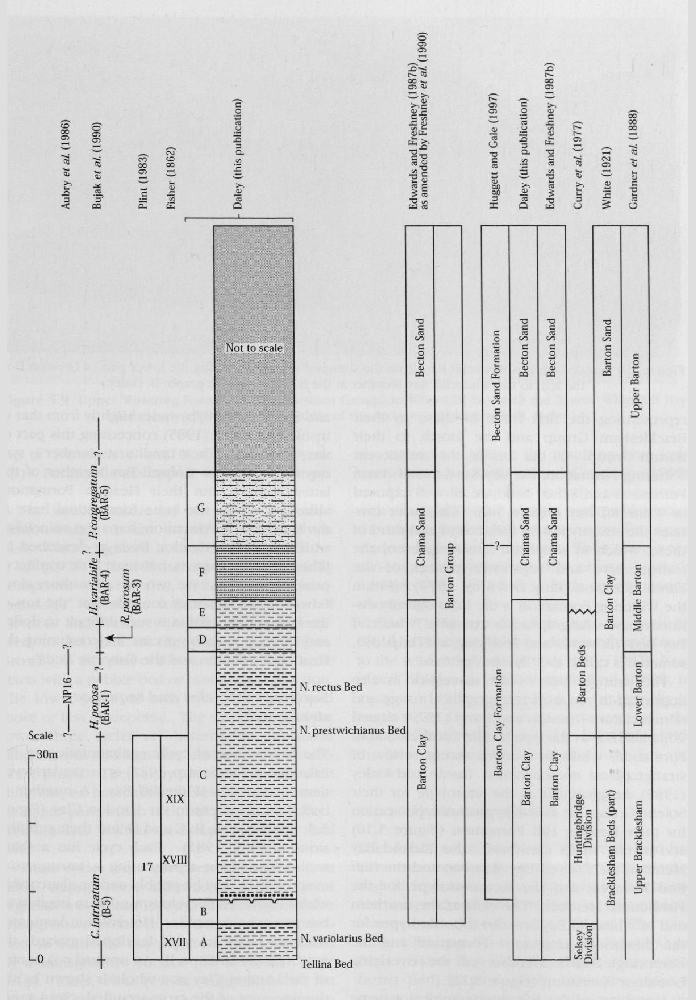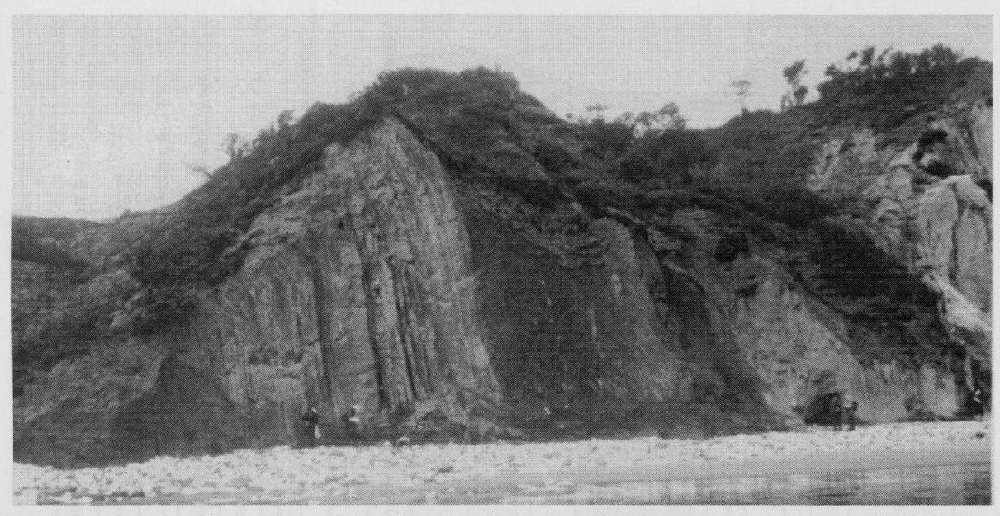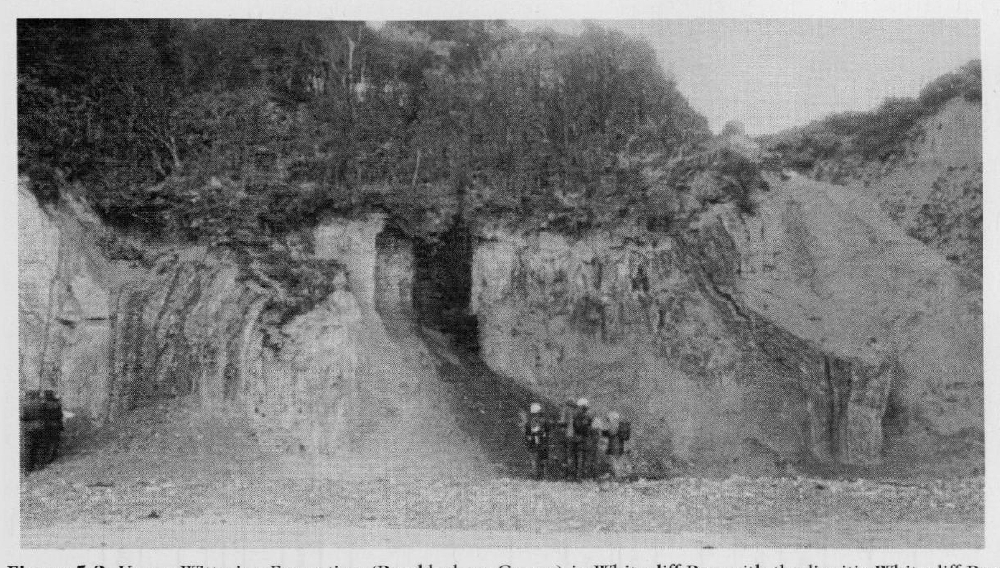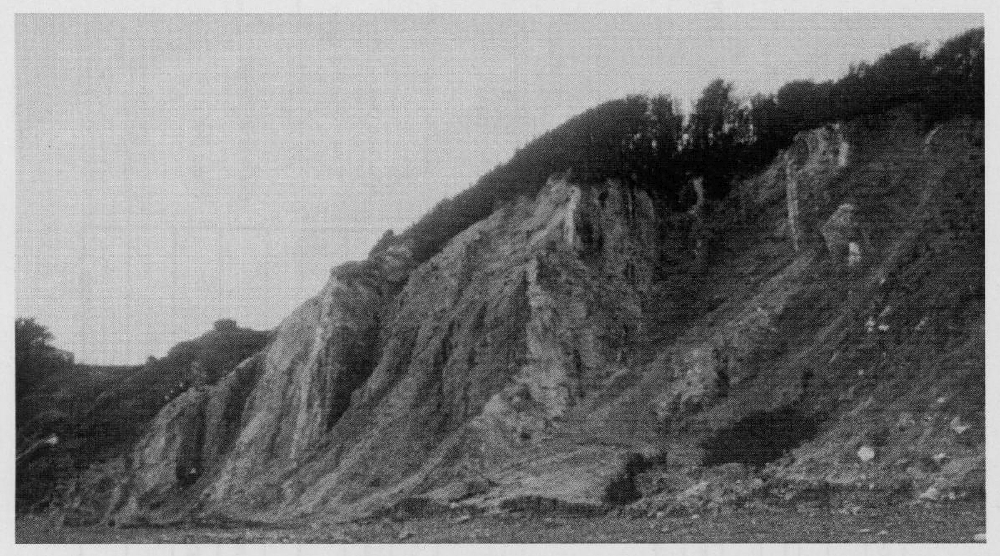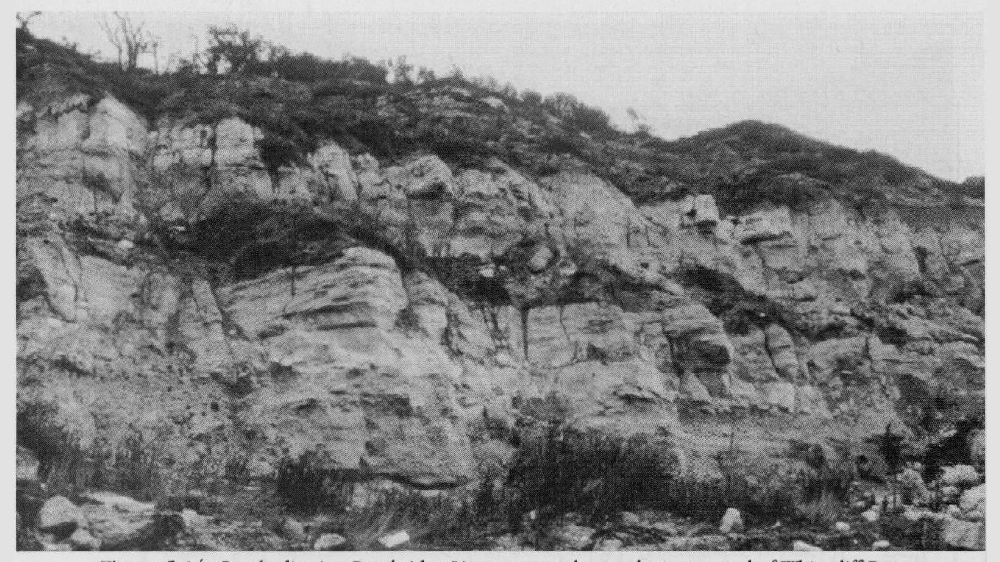Whitecliff Bay, Isle of Wight
Highlights
Whitecliff Bay contains the most stratigraphically extensive and important Palaeogene section in Western Europe. It is the type section for over 15 stratigraphical units and demonstrates, more than any other site, the characteristically cyclic nature of the British Palaeogene succession. A wide variety of marine and non-marine environments are represented by the section which has also proved of particular importance in micropalaeontological and magnetostratigraphical zonation and correlation.
Introduction
The section of Palaeogene strata in Whitecliff Bay
Whitecliff Bay and its continuation north-eastwards into Howgate Bay
The latter part of the 20th century has seen an upsurge of interest in the section and its potential as a key to palaeoenvironmental and palaeogeographical interpretation of the Palaeogene in southern Britain. Following early studies of the large foraminifer Nummulites (Curry, 1937; Wrigley and Davies, 1937), research has been undertaken on the microfauna and microflora: Bhatia (1955, 1957) and Murray and Wright (1974) on the foraminifera, Haskins (1968a,b,c, 1969, 1970, 1971a,b) and Keen (1977) on the ostracods, and a number of workers on the microplankton (see Bujak et al. (1980) for a list of references). The microfaunal studies have made major contributions to our understanding of aqueous Palaeogene palaeoenvironments, particularly regarding palaeosalinity. Work on the siliceous microplankton in particular (dinoflagellates and acritarchs) has markedly improved the correlation of clastic Palaeogene sequences such as that in Whitecliff Bay (Costa and Downie, 1976; Bujak et al., 1980) whilst at some horizons, calcareous nannoplankton are biostratigraphically important (Aubry, 1986; Aubry et al., 1986). Other microfloral work on the section includes that of Gruas-Cavagnetto (1976) on the palynology and Feist-Castel (1977) on the charophytes.
Broader stratigraphical/palaeontological studies, including work by Edwards (1967), Daley (1969, 1973a), Insole (1972) and King (1981), have considerably improved our understanding of the wide variety of shallow marine to freshwater environments represented by the Whitecliff Bay site. Plint's (1983a, 1988a) sedimentological work on the
Mineralogical studies have included work on the heavy minerals by Walder (1964), Blondeau and Pomerol (1968) and Morton (1982b), and on the clay mineralogy by Gilkes (1968, 1978).
Not surprisingly, the thick succession of Whitecliff Bay has interested those concerned with regional and international correlation. Glauconites from the section were used by Odin et al. (1969, 1978) in radiometric dating of the Palaeogene strata, whilst the importance of the site to magnetostratigraphy was demonstrated by Townsend and Hailwood (1985). In conjunction with the Bouldnor Cliff section, Whitecliff Bay was selected to typify the English succession spanning the Eocene–Oligocene boundary (Curry and Hailwood, 1986). How the succession in Whitecliff Bay relates to that of northwestern Europe is referred to in the recent comprehensive paper on the sequence stratigraphy of this region by Neal (1996).
Various aspects of the site have been described in reports of field meetings such as those arranged by the Geologists' Association (Stinton, 1971a; Daley and Edwards, 1974) and for international conference excursions (Curry, 1968). A brief guide to the section is given in the Geologists' Association Guide to the Isle of Wight (Daley and Insole, 1984), recently revised and updated by Insole, Daley and Gale (1998). An account of the succession of the Thames, Bracklesham and Barton Groups obtained from foreshore exposures has recently been published by Huggett and Gale (1997). More recently, Daley (1999, pp.7–29) has written a comprehensive re-evaluation of the section.
This site was also independently selected for its fossil plant and mammal content, more detailed accounts of which can be found elsewhere in the GCR series (Mesozoic to Tertiary Palaeobotany of Great Britain (Cleal and Thomas, in prep.); Fossil Mammal and Birds of Great Britain (Benton et al., in prep.)).
Description
The stratigraphical succession of the Palaeogene strata in Whitecliff Bay is summarized in
In the southern part of Whitecliff Bay, the Palaeogene strata are vertical, striking E–W, reflecting the steep, northern monoclinal limb of the Sandown Anticline. Northwards, the dip changes within a short distance such that by Black Rock Point
Lithological succession
Five lithostratigraphical groups are represented in the Whitecliff Bay succession: the
Sands are well developed at certain horizons. The stratigraphically adjacent Portsmouth Sand and Whitecliff Sand members of the London Clay and the Becton Sand, all three being light-coloured, 'clean', quartz-rich sands, are visually distinctive units. Glauconitic sands are developed in the lower part of the succession, for example in the
Heterolithic lithologies are well developed at certain horizons and are well seen in the London Clay and the
Limestones are best developed, with associated marls, in the Bembridge Limestone
Stratigraphy
The exposure of a thick sequence within a short extent of coast attracted the early attention of geologists attempting to establish the stratigraphical succession of the local Tertiary rocks. For many years, the subdivisions and nomenclature proposed in the 19th century were widely accepted. In the latter part of the 20th century, a renewed interest in this and other Palaeogene sections has led to new proposals on stratigraphical subdivision and nomenclature, e.g. Stinton (1975), Curry et al. (1978), King (1981) and Edwards and Freshney (1987b). Such changes have been prompted by a need to standardize stratigraphical usages, as well as the recognition that units defined at one locality, such as Whitecliff Bay, were of limited application elsewhere even within the Hampshire Basin, because of the lateral variation characterizing the paralic context in which the local Palaeogene strata accumulated.
Some of the proposals stimulated discussion on the validity of certain stratigraphical units (see Daley et al., 1979) and, whilst there is now general agreement concerning the subdivision and nomenclature of the Whitecliff Bay sequence, some differences of opinion persist. The wider stratigraphical importance of Whitecliff Bay was recognized by the middle of the 19th century. Careful study of the older part of the succession both here and in Alum Bay led to Prestwich (1846, 1847a) establishing the equivalence of strata in the Isle of Wight, the adjacent mainland of Hampshire and Sussex, and the London Basin (see King, 1981, p. 10 for further details). Fisher (1862) also recognized the importance of Whitecliff Bay in his important and still useful detailed study of the 'Bracklesham Beds', in part because exposures are so much better than in Bracklesham Bay.
Lithostratigraphy
In relatively recent times, the continuing stratigraphical importance of Whitecliff Bay is reflected in its use as a type locality for a number of different stratigraphical units of the Palaeogene succession. The section of the former Tilehurst Member (the Oldhaven Formation of King, 1981) is one of two hypostratotypes for this unit (but see later discussion). King (1981, p. 21) designated the Whitecliff Bay section of the
Whitecliff Bay also contains the 'stratotypes' for the four stratigraphically informal 'divisions' of the 'Bracklesham Beds' recognized by Curry et al. (1977): the Wittering division (Fisher Beds I to V), the Earnley division (VI to VIII), the Selsey division (IX to XVII) and the Huntingbridge division (XVIII to XIX)
Following modern 'Hedbergian' principles, Edwards and Freshney (1987b) assigned strata representing the first three of these to their
The younger part of the succession is also important in terms of stratigraphical usage and nomenclature. Stinton and Curry (1979) named Whitecliff Bay as the type locality for their Solent Formation, whilst in a more recent review of stratigraphical nomenclature, Insole and Daley (1985) designated it as the stratotype for their
A revision of the lithostratigraphical scheme for the Hampshire Basin Palaeogene by Edwards and Freshney (1987b) varies slightly from that of Insole and Daley (1985) concerning this part of the succession. Their
Sedimentary cycles and sequence stratigraphy
The importance of cyclic sedimentation in the Palaeogene (see Stamp, 1921) is particularly well demonstrated in Whitecliff Bay. A number of cycles are apparent in the London Clay (
The cyclic nature of the sequence, also demonstrated in the overlying Bracklesham Beds, was recognized in the 'divisions' of Curry et al. (1977). Their Wittering 'division' actually comprises two cycles, whilst their Huntingbridge 'division', following the usage of Edwards and Freshney (1987b), is now considered to be part of the Barton Clay above. Broadly, in this part of the succession, each cycle starts with a pebble bed or bioturbated junction. The lower parts of each cycle are shelly, and more or less glauconitic. The upper parts of the lower three cycles are heterolithic, laminated sands, muds and lignites, lacking macroinvertebrate fossils. The Selsey 'division' is somewhat different; no heterolithic development occurs in its upper part, which includes the cross-bedded, well-lithified 'Tellina sandstone' of Fisher Bed XVI.
These cycles were interpreted as reflecting an initial transgression followed by a subsequent regression by Plint (1983a), who recognized five transgressive events in his 'Bracklesham Formation' in Whitecliff Bay
Plint (1988a) concluded that the cyclicity could be related with some degree of confidence to the sea-level curves of Haq et al. (1987). Neal et al. (1994) and, more recently, Neal (1996), in a paper on Palaeogene sequence stratigraphy in north-west Europe, have referred to the Whitecliff Bay succession and its correlation with the Palaeogene succession in the North Sea and elsewhere.
Invertebrate macrofauna
The fossil macrofauna of Whitecliff Bay has attracted attention since the early 19th century and rich faunas occur at certain horizons. Marine, predominantly molluscan, macrofaunas are well developed in the London Clay (see King, 1981, pp. 76–7) and in the Bracklesham Beds. Fisher Bed XVII (the Nummulites variolarius Bed) is particularly interesting since it contains, in addition to its molluscan fauna, the small coral Turbinolia.
The Barton Clay is poorly exposed, although the so-called 'Chama Bed' at its top contains a shallow-water fauna including Charna squamosa. Above the barren (decalcified) 'Barton Sand' (the Becton Sand of Edwards and Freshney, 1986), the
By contrast, the
The
Microfauna
The microfaunas of Whitecliff Bay have been the subject of considerable research. The importance of the foraminifer genus Nummulites in Palaeogene correlation was recognized in the 19th century (see Curry et al., 1978, p. 13, for details), with Bowerbank (1842) the first to note its presence in Whitecliff Bay. Various species occurring at several horizons within the Bracklesham and Barton Groups have aided both local and international correlation. Subsequently, various Nummulites species were the subject of considerable attention (see Murray and Wright, 1974, p. 15, for details), including an important 20th century contribution by Curry (1937).
Following earlier foraminiferal studies by Bowen (1954), Bhatia (1955, 1957) and Kaasschieter (1961), Whitecliff Bay proved to be an important locality in the major study undertaken by Murray and Wright (1974). Benthic forms predominate, but in the London Clay, planktonic foraminiferids are well represented and are reported to be more abundant in this formation in Whitecliff Bay than at any other horizon or locality in the Hampshire Basin. Wright (1972) recognized the first appearance of planktonic foraminifera in the succession around 40 m above the top of the
Most of the foraminiferid faunules recognized by Murray and Wright (1974) comprise low-diversity assemblages, interpreted as indicating mainly hyposaline conditions. Fully marine conditions are, however, represented by some assemblages in Fisher Beds XIV–XVII, which yield the most abundant foraminiferid faunas of the Whitecliff Bay succession. Normal or even slightly hypersaline salinities are indicated by the foraminiferid assemblages in the
The ostracods from Whitecliff Bay have also been extensively studied. Haskins (1968a,b,c, 1969, 1970, 1971a,b) sampled the whole succession, whilst Keen (1977) concentrated on the
Calcareous nannoplankton biostratigraphy
Calcareous nannoplankton are not common in Whitecliff Bay, but what does occur is significant for correlation (see Martini, 1970a). Aubry et al. (1986) were unable to identify any calcareous nannofossil (NP) biozones in the London Clay or 'Bagshot Beds'. The lowest datable level, Fisher Bed IV, indicates upper Zone NP12/lower Zone NP13. Fisher Bed VII also contains common and relatively well-preserved nannofossils, and whilst no zonal marker was found by these authors, they suggested a likely assignment to upper Zone NP 14. Calcareous nannoplankton are rare in the
Dinoflagellate biostratigraphy
Whitecliff Bay has proved to be a major locality for the study of dinoflagellate cysts and acritarchs, which have revolutionized our understanding of the Palaeogene Beds of southern England (see Bujak et al. (1980) for a review of research undertaken and a reference list). It was an important locality in a study of the dinoflagellate microflora of the London Clay (Williams, 1964 and in Davey et al., 1966). Eaton's recognition of five dinoflagellate zones in the Bracklesham Beds (Eaton, 1971a, 1971b, 1976) was likewise based on a study of the rich microflora from Whitecliff Bay, together with that from Alum Bay. Whitecliff Bay was also an important locality for dinoflagellate research on the Barton Beds by Bujak (1976, 1979). Other dinoflagellate work on the section includes that of Costa and Downie (1976) on the valuable dinoflagellate zone fossil Wetzeliella, and it was one of the two localities studied by Liengjaren et al. (1980) in their research on the upper part of the local Palaeogene succession (the
Of the 13 dinoflagellate cyst assemblage zones erected by Bujak et al. (1980) and based on this earlier work, eight have Whitecliff Bay as a type locality.
Charophytes
Charophyte gyrogonites occur in mainly freshwater sediments towards the top of the succession (Groves, 1926) and are most obvious at certain horizons in the Bembridge Limestone. Their occurrence is important stratigraphically (Grambast, 1962), with Whitecliff Bay the type section for the charophyte Bembridge Zone, the lowest of five charophyte zones assigned to the Oligocene (Castel, 1968). The other type localities are all in France. Details of the characean material found are given in Feist-Castel (1977).
Magnetostratigraphy
In addition to its palaeontological significance, Whitecliff Bay is an important locality for magnetostratigraphical research. Townsend and Hailwood (1985) obtained their most complete magnetostratigraphical sections from the two Isle of Wight localities, Whitecliff Bay and Alum Bay. The former proved important in the subsequent study by Aubry et al. (1986) on magneto-nannostratigraphical correlation, particularly concerning the
Detrital mineralogy
Compared with other aspects of geology, relatively little mineralogy work has been undertaken in Whitecliff Bay. It was the main section sampled by Walder (1964) in her study of Eocene heavy minerals and was also investigated by Blondeau and Pomerol (1962). Later, Morton (1982b) used material from the section in a study attempting to restate the value of heavy minerals in correlation. He recognized three suites from 'Scotland', Armorica and Cornubia whose influences vary up the succession. Amongst his conclusions was that the first definite occurrence of the Cornubian suite represents a major palaeogeographical change 'with the first uplift and exposure of the Cornubian landmass in Tertiary times'. It coincides with the dramatic influx of tourmaline noted by Blondeau and Pomerol (1968) in the Whitecliff Bay succession in Fisher Beds IV, V and VI. Morton considers that this part of the succession is the most regressive of the entire sequence.
Clay mineral studies have been undertaken by Gilkes (1968, 1978), whilst glauconites, common at several horizons, were used by Odin et al. (1969) in their work on the radiometric dating of the local Palaeogene strata. Recent work on glaucony includes that by Amorosi and Centineo (1997) and Huggett and Gale (1997).
Sedimentology
Although Whitecliff Bay has enormous potential for sedimentological research, relatively little has been published on this aspect of the site. The sediments of the London Clay are but briefly described in King's (1981) predominantly stratigraphical paper. By contrast, the
The section was studied in some detail by Edwards (1967) in his comprehensive palaeoen-vironmental investigation of the
The succeeding
Just above the 'Bembridge Oyster Bed', the lateral equivalent of the 'Insect Limestone' at Gurnard (but virtually bereft of insects) contains a variety of beautifully preserved, small-scale water-escape structures (Daley, 1971). A little above, Daley (1974) found fossil blue-green algae (the first described from the Hampshire Basin) encrusting the surfaces of bivalves. In the upper part of the member, fining-upwards cycles have been described (Daley, 1973b). At the base of one of these an unusual and well-preserved suite of sedimentary structures includes elastic pseudomorphs after gypsum (Daley, 1967), gutter casts and palaeoslope-influenced parallel crack fills (Daley, 1968).
Less than 0.5 km north-eastwards from Black Rock Point, the Palaeogene cliff section ends. The remainder of the section comprises almost horizontal hard units within the Bembridge Limestone, together with the 'Insect Limestone', which are exposed on the foreshore at low tide. In this part of the section, Daley and Edwards (1971) recognized that the
Interpretation and evaluation
Within a distance of just over 1 km, the just over 550 m of strata exposed in Whitecliff Bay represent some 15 million years. Not surprisingly, the site as a whole has provided a vital source of data from which much has been ascertained about the local Palaeogene palaeogeography and palaeoenvironments. Stratigraphically, it is more extensive than any other single Palaeogene site in Britain, even if Alum Bay and Headon Hill are considered as a single locality. It is, therefore, of considerable national and indeed international importance.
Since the 19th century, perhaps more than any other site, Whitecliff Bay has provided a basis for establishing the Hampshire Basin Tertiary succession. It cannot, of course, be regarded as either a representative or typical succession, since due to the paralic nature of the local Palaeogene palaeogeography, considerable lateral environmental and therefore stratigraphical variations occurred. However, it broadly represents a more marine influenced succession than localities such as Alum Bay and the Dorset sites further west.
Comparison with other localities
Whitecliff Bay differs from other Palaeogene sites in various respects, at some horizons more so than others. At the bottom of the succession, the
Comparison and lithological correlation of the Palaeogene of the Hampshire Basin is made difficult by marked lateral facies changes, but in recent years relationships from one locality to another have become more readily understood by what has come to be called 'event stratigraphy'. This has emphasized the importance of cyclicity in the Palaeogene sediments of the Hampshire Basin (see Curry et al., 1977), by showing that packages of strata are separated by transgressive surfaces. The well-exposed and continuous Whitecliff Bay succession has provided a sound basis for this approach. As many as seven transgressive events have been recognized here from the London Clay (King, 1981), whilst five were recorded from the 'Bracklesham Formation' by Plint (1983a).
Higher up the succession in Whitecliff Bay, the
The uppermost
Above, the Bembridge Limestone (one of the best examples of a freshwater limestone in the British stratigraphical column) is both at its thickest and best in Whitecliff Bay, whilst the succeeding
Stratigraphy
The importance of the site in terms of formal stratigraphy is considerable and more so than any of the other onshore Palaeogene localities in Britain. In the 19th century, Fisher (1862) considered that Whitecliff Bay provided a better section of the Bracklesham Beds than Bracklesham Bay, whilst, as mentioned earlier, it has the only complete section of the London Clay and its constituent divisions (King, 1981). Altogether, it provides type sections (stratotype, hypostratotype, lectostratotype) for one group, four formations and eleven members, of which most, although not all, are accepted as valid stratigraphical units. Whitecliff Bay was also the type section for the four informal 'divisions' of Curry et al. (1977) (see earlier discussion of 'event stratigraphy').
Amongst the 'disputed' units of Whitecliff Bay is that named the Oldhaven Formation by King (1981). The author concurs with the view of Edwards and Freshney (1987b) that, at least in the Hampshire Basin, this is not sufficiently distinct lithologically to be considered as a separate 'mappable' formation. The Tilehurst Member of King (1981) in Whitecliff Bay therefore might revert to Prestwich's (1850) original term, the London Clay Basement Bed. Alternatively, member status could be retained but within the London Clay rather than the Harwich Member of Ellison et al. (1994), since it is uncertain whether the latter has validity as a formation in the Hampshire Basin.
A number of named units in Whitecliff Bay have titles of some antiquity. Over recent years, and particularly under the influence of Hedberg (1976), some of these have already disappeared or will disappear from the local stratigraphical terminology, whilst the limits of others have been redefined. An example is the term 'Bagshot Sands', now omitted from the formal terminology and almost certainly least to be mourned, since although widely used historically in both the Hampshire and London Basins, both definition and recognition have been difficult. Inevitably, there is as yet no universal agreement as to what names should be used but a general concensus exists, based on Edwards and Freshney (19876) and Daley and Insole (1985).
The
The problems of defining boundaries between different stratigraphical units is also exemplified by the Bracklesham/Barton junction in Whitecliff Bay. Traditionally (see, for example, White, 1921), Fisher Beds I to XIX were included in the Bracklesham Beds, with the base of the Barton Beds defined by the appearance of N. prestwichianus (elegans). Curry et al. (1977) followed this tradition by including all the Fisher Beds from I to XIX in their
Following Hedberg (1976), it has become clear that the muddy units originally included in the highest Bracklesham Beds, both in Whitecliff Bay and elsewhere, are better reassigned to the Barton Clay. Edwards and Freshney (19876) transferred the Huntingbridge 'division' of Curry et al. (1977) to the Barton Clay, as was earlier done though not overtly stated in Daley and Insole's (1984) account of the Whitecliff Bay succession. Edwards and Freshney (1987b) also placed the N. variolarius Bed of Whitecliff Bay (Fisher Bed XVII) in the Barton Clay, arguing that differentiating the latter from the underlying formation was essentially one of sand content. However, as a result of grain size analysis by Freshney et al. (1990) which showed it to predominantly comprise sand and silt, this unit has been reassigned to the Selsey Sand. Hence, the lithified and easily identifiable 'Tellina Bed' (Fisher Bed XVI) occurs a little below rather than at the top of this formation.
Chronostratigraphy and biostratigraphy
Our now considerably improved understanding of the lithostratigraphy of Whitecliff Bay and its relationship to other localities has been parallelled by chronostratigraphical and biostratigraphical work aiming to achieve a sound understanding of time equivalence both locally, nationally and internationally. To this end, research in Whitecliff Bay has made a major contribution. The latter reflects two advantages which this section has over all others of the British on-land Tertiary succession. Firstly, there is its stratigraphical extent and continuity. Secondly, its greater proportion of marine strata has facilitated the use of marine zone fossils which are absent or poorly represented at some other localities.
Foraminifera
Early work on the section demonstrated that the different species of Nummulites characterizing a number of horizons in the
Calcareous nannoplankton
Both the zonal scheme for planktonic foraminifera and that for calcareous nannoplankton have proved of limited value as far as British sites are concerned. However, some nannoplankton dates have been obtained from Whitecliff Bay and have contributed to a better understanding of how the local succession fits into a wider European regional context (Neal et al., 1994; Neal, 1996).
Martini (1970b), in dating the Brockenhurst Bed (base of
Dinoflagellates
Research on Whitecliff Bay has contributed to the development of a variety of zonal schemes based on dinoflagellates. Here, Eaton (1971a, 1971b) recognized five microplankton zones which have facilitated the correlation of the perplexingly different lithological sequences at Whitecliff and Alum Bays. The importance of the section is further emphasized by the fact that of the 13 dinoflagellate zones established by Bujak et al. (1980), eight have Whitecliff Bay as the type section.
Studies of the dinoflagellate genus Wetzeliella (sensu lato) from the site have contributed to the development of a correlation scheme based on species of this fossil (Costa and Downie, 1976).
Interestingly, Wetzeliella dates for the top of the London Clay here are older than at Sheppey but younger than for sites further west in the Hampshire Basin. The D. varielongituda zone is the highest zone present in the London Clay (sensu King) of Whitecliff Bay, whilst to the west at Studland, the top of the formation is in the W. meckelfeldensis zone. The top of the London Clay is therefore strongly diachronous.
Depositional environments
In terms of palaeogeographical reconstruction, Whitecliff Bay, more than any other locality, demonstrates the cyclic nature of the Palaeogene succession of south-eastern England, with the recognition of approaching 20 transgressive events. However, despite the common occurrence of marine macrofossils at many horizons, research has indicated that the development of open sea conditions was the exception rather than the rule. Murray and Wright (1974) have suggested that much of the succession from the London Clay to the Barton Clay represents river-influenced shallow shelf conditions with hyposaline waters. Only on relatively few occasions, such as the period represented by Fisher Beds XIV–XVII in the
The heterolithic, sometimes lignitic, lithologies of the London Clay and
Whilst aspects of the sequence once considered to be regressive may possibly represent brackish transgressions (see p. 97), there are three stratigraphical levels for which a regressive interpretation remains valid.
An early substantial regression is represented by the
A second major regressive event is represented within the
A third major regression, well demonstrated by the Whitecliff Bay succession, commenced with the shallowing initiated by the deposition of the Becton Sand and led to the long period of essentially non-marine to marginal-marine conditions represented by the
Although Whitecliff Bay has been the subject of greater study than any other single Palaeogene site, with the possible exception of Sheppey, the research potential of the section remains considerable. Palaeoenvironmental reconstructions based on sedimentological studies are, with some notable exceptions, for the most part incomplete and/or unpublished. Modern studies of the invertebrate macrofaunas, e.g. those of the
Conclusions
For a variety of reasons, Whitecliff Bay is one of the most important Palaeogene sites, not only in Britain, but internationally. With more than 550 m of strata ranging from Palaeocene to late Eocene/early Oligocene age, it is probably the most continuous exposure of sediments of this age in western Europe.
Whitecliff Bay in particular has been studied since the 19th century and is the subject of numerous publications. The importance of its contribution to our understanding of the Palaeogene is therefore considerable. Historically, it was of major importance to those early geologists attempting to establish the local Palaeogene succession, whilst very recently it has been proposed as the UK magnetostratigraphical type section.
The site has achieved recognition from many different standpoints. It is the type section for over 15 lithostratigraphical units. From another stratigraphical standpoint, it demonstrates Palaeogene cyclicity more clearly than any other British site. A series of 'events', in particular transgressions of various magnitudes and regressions, are represented, and consequently the site includes strata recording a wide variety of environments from shallow marine to freshwater. A feature of the succession is the predominance of marine environments early on and the increasing importance of brackish and freshwater strata in the upper part of the sequence.
The palaeontological aspects of the site have made significant contributions both to our understanding of the local Palaeogene palaeoenvironments and palaeogeography and in terms of zonation and correlation.
Foraminiferal studies in Whitecliff Bay have indicated that, even for the parts of the succession traditionally considered to be marine, the sea was for the most part hyposaline. Rich molluscan faunas occur at some horizons, but corals, echinoids and other forms more associated with wholly marine salinities are rare. Higher up the succession, faunas with low species diversity are associated with brackish to freshwater environments.
From the point of view of correlation, the early recognition of different species of Nummulites in Whitecliff Bay provided a basis for correlation. Later studies of planktonic foraminifera and phytoplankton revolutionized Palaeogene zonation and correlation. Whitecliff Bay has made a major contribution, in particular, to the development of dinoflagellate zonation. Of the 13 dinoflagellate zones established for the London Clay to Barton Clay succession, eight have Whitecliff Bay as the type locality. More recently, integrated bio/magnetostratigraphical research has enhanced our understanding of the Whitecliff Bay sequence and its correlation with other Palaeogene sequences in the north-west European area, including those of the North Sea.


